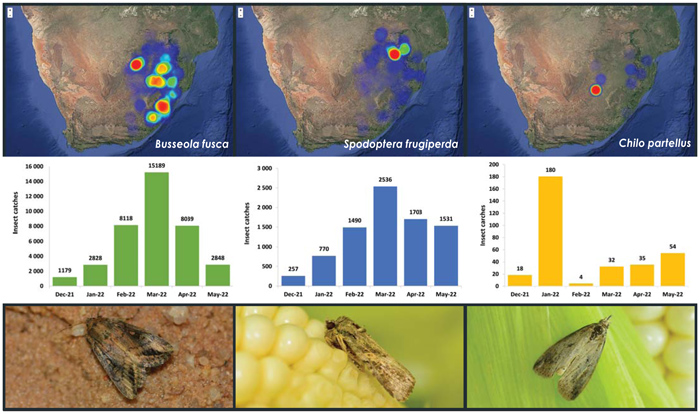Lepidoptera (moths and butterflies) are some of the most damaging pests in agriculture, including on grain crops. The most important of these on maize in South Africa are Busseola fusca (African maize stalk borer), Spodoptera frugiperda (fall armyworm) and Chilo partellus (spotted stalk borer).
These pests are managed with Bt resistance genes in the maize crop and/or chemical pesticides. As such these pests impose a major cost on the industry, both from the loss in productivity and the inputs to manage them.
While these pests are well known and studied in South Africa, there are many knowledge gaps that are important to guide management interventions. Understanding the distribution of infestation hotspots (where) of these pests (what) and during which part of the season (when) are some of these knowledge gaps.
While some of these pests have been monitored in some regions for some period of the season, there is currently no national monitoring effort for all three pests across all major maize-growing regions in the country and across the whole season.
Bridging the gap
In November of 2021 a group of partners launched a national surveillance effort to address this knowledge gap, including researchers at the Forestry and Agricultural Biotechnology Institute (FABI) linked to the National Grain Research Programme, Cropwatch Africa and Grain SA. The surveillance covered Limpopo, Mpumalanga, North West, the Free State, KwaZulu-Natal and the Eastern Cape, with 40 pheromone-baited traps per pest per province that were monitored from December 2021 to May 2022.
In total 38 201, 8 287 and 323 moths were caught for B. fusca, S. frugiperda and C. partellus, respectively, over the course of the season.
For B. fusca the most moths (8 085) were caught in the Eastern Cape, followed by KwaZulu-Natal and the Free State, still fewer in Mpumalanga and North West, and the lowest number (only 2 025) in Limpopo. The first moths were already caught in December 2021 in all surveyed provinces, and rapidly increased to peak in February 2022 in North West, Mpumalanga, Limpopo and the Free State, while populations only peaked during March 2022 in KwaZulu-Natal and the Eastern Cape.
For S. frugiperda the highest catches (5 092) were recorded in Limpopo, followed by KwaZulu-Natal and Mpumalanga, with low numbers recorded for North West, the Eastern Cape and the Free State. These numbers follow the known areas where the moth can overwinter, breed and disperse from the north to colonise the rest of the country during the warmer growing season. Anecdotal evidence suggests that the fall armyworm has displaced B. fusca in northern regions, where B. fusca used to be more prevalent.
For C. partellus notably fewer moths were caught than for the other species. Here the highest catches (127) were recorded in the Free State, followed by roughly equal numbers in all the other provinces except the Eastern Cape, where almost none were detected.

A call to action
It is important to remember that these patterns are not necessarily reflective of every season and can be influenced by climatic factors. It is crucial that such surveillance efforts continue to inform research linked to understanding the influence of weather conditions on life cycles, to delineate hotspot areas that persist over many seasons, and to inform management options.
A collective partnership between producers, agricultural companies, government, and research organisations will be required to support such an effort.
In addition to a structured surveillance program, there is much opportunity to connect data from all these players that are being recorded, but are not yet shared in a collective and public manner. Access and integration of such data are of national interest, and efforts in this regard have been initiated via the National Biosecurity Hub and the associated Information Hub digital platform.
More detail and further updates in terms of regional hotspots from currently collated data via the Information Hub can be seen at the link www.fabinet.up.ac.za/maizepests.
We welcome partners in this important national initiative. Interested parties can contact Prof Bernard Slippers at bernard.slippers@fabi.up.ac.za, Roedolf Nieuwenhuis at roedolf@cropwatch.co.za or Dr Miekie Human at miekie@grainsa.co.za.



















